Ro and the Goma
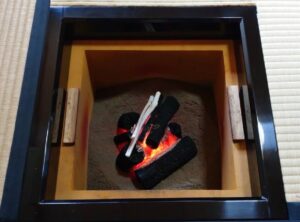
The sunken hearth in a cha-shitsu, 茶室, tea-room, called a ro, 炉, hearth, is set with sho-zumi, 初炭, first-charcoal, sumi-bi, 炭火, charcoal-fire. The ro-dan, 炉壇, hearth-foundation, is masonry with sand finish, and is about half-ful of wood hai, 灰, ash. On the upper ledge of the rodan are two pieces of wood called suki-gi, 透木, clear-wood, that support a suki-gi gama, 透木釜, clear-wood kettle, that has a wide, flaring flange. The ro has a black lacquered wooden frame, ro-buchi, 炉縁, hearth-edge, that protects the surrounding tatami.
The ideal, traditional ro-dan, 炉壇, hearth-foundation, is made of masonry as pictured above. It is constructed in the manner of traditional Japanese architecture. Other materials used to make the rodan include low-fired ceramic such as Ō-hi yaki, 大樋焼, Great-trough fired, tetsu, 鉄, iron, akagane, 銅, copper, etc.
A kettle that is more typical for the ro requires the use of an iron trivet, go-toku, 五徳, five-virtue. The sukigi gama does not require a gotoku as its flange rests on the edge of the rodan resting on wooden blocks. These wooden blocks, sukigi, will be investigated later in this text.
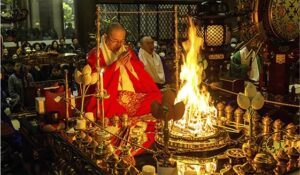
Daily fire rituals of Shin-gon-shū, 真言宗, True-vow-sect, temples, are to dispel human desires that deter people from gaining enlightenment. Goma is the Japanese word for the Sanskrit homa. The goma rites have been adopted by other Buddhist sects, and other traditions.
Kō-ya-san, 高野山, High-field-mountain was founded by Kū-kai, 空海, Void-sea, who introduced the goma rites. Before he went to Kōyasan, he founded a temple in the mountains of Taka-o, 高雄, High-male, near where Hei-an-kyō, 平安京, Level-peace-capital, would be established in 784.
Taka-o Jin-go-ji, 高雄神護寺, High-male God-protect-temple, is near Kō-san-ji, 高山寺, High-mountain-temple, northwest of Kyōto, also was founded by Kū-kai, 空海, Void-sea, after he returned from China. He is called Kō-bō Dai-shi, 弘法大師, Vast-law Great-master. Jingoji is located in the Takao in the vicinity of Kō-san-ji, 高山寺, High-mountain-temple, established by Myō-e Shō-nin, 明恵上人, Wisdom-blessing Upper-person. At the temple, Myōe planted tea seeds given to him by Ei-sai Zen-shi, 栄西禅師, Excel-west Zen-master, after his return from studies in China. Eisai brought not only tea and its rites with him, he introduced Chan Buddhism, that became Zen in Japan.
Later, in 816, Kūkai established on the crest of Kō-ya-san, 高野山, High-field-mountain, the temple of Kon-gō-bu-ji, 金剛峰寺, Gold-strength-summit-temple. The temple was first constructed as Sei-gan-ji, 誓願寺, in 1593 by Toyotomi Hideyoshi on the death of his mother. It was rebuilt in 1861, and was given its present name Kongōbuji in 1869. The rite of Goma is enacted daily at the temple.
The go-ma-dan, 護摩壇, Protect-polish-altar, fire altar, is identified as a mandala. The size of the altar varies from 105 to 135 cm square: 3.5 to 4.5 shaku kane-jaku or 3.6 shaku kujira-jaku. The altar is 135 cm square, 4.5 shaku kane-jaku or 3.6 shaku kujira-jaku.
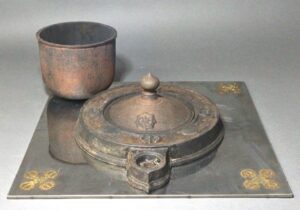
Temple and Buddhist utensils: square go-ma ro, 護摩炉, goma hearth; W. 42cm. – 14 sun kane-jaku square; circular go-ma kama, 護摩釜, goma kettle, with futa, 蓋, lid: diam. one shaku kane-jaku; for goma taki, 護摩焚き, goma fire. The designs include double vajra, kon-gō-sho, 金剛杵, gold-strength-pestle, and hō-rin, 法輪, law-ring. The petal-like projection from the front of the circular cover, would contain ghee to ladle to fuel the fire.
The oil that is used in the goma rites, is Ghee, clarified butter made from cow’s milk. In Japanese ghee is known as so-yu, 酥油, cow milk-fat. Ghee is an essential part of the diet in Hindu, Ayurvedic, and Buddhist traditions, as well as in daily life. Another type of oil is made from the petals of the blue lotus, which has many benefits, but is challenging to produce is costly to purchase. Perhaps the ghee is in lieu of blue lotus oil. Nevertheless, cows are sacred to many cultures, and the milk of cows is poured over sacred images and objects. Ghee is poured in small amounts to help ignite the votive wooden sticks, go-ma–ki, 護摩木, protect-polish-wood.
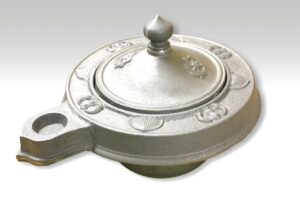
The sacred Buddhist fire is built in an iron go-ma kama, 護摩釜, protect-polish kettle, which is set in the center of the goma-dan, 護摩壇, goma-altar. The size of gomadan varies from one to three shaku kane-jaku.
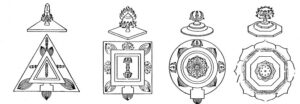
There are various forms of the goma-ro, 護摩炉, protect-polish-hearth; triangular, square, round, lotus. The goma hearth and accompanying utensils have designs of lotus and vajra motifs, just as the robuchi in the chashitsu may be decorated with gold and color lacquer motifs. The tearoom robuchi design motifs do not include the lotus or the vajra, perhaps because of their profound association with Buddhism.
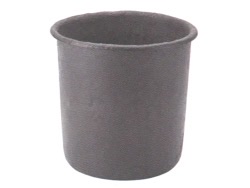
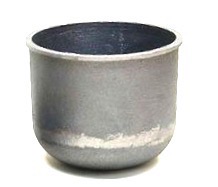
A ganro is often present in table-like cabinets, such as the mi–sono-dana, 御園棚, Hon.-garden-shelf, which is used with stools and other tables for host and guest to sit. Where the participants stand when greeting each other is called ryū-rei, 立礼, stand-bow.
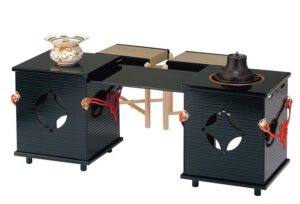
The mi–sono-dana, 御園棚, Hon.-garden-shelf, choice of Tan-tan-sai, 淡々斎, Light-light-abstain, XIV Iemoto, Urasenke. The gan–ro, 丸炉, round-hearth, is a cylindrical copper bucket with a kama is located in the cabinet on the left side, and a mizu–sashi, 水指, water-indicate, is displayed on the left side, which is the standard relationship in a hon-ga-tte, 本勝手, true-prevail-hand, cha-shitsu, 茶室, tea-room. Tea bowls and other utensils are placed inside the shelved cabinets. In a sense, the misono-dana with it’s ganro bears a close resemblance to the Gomadan. The misono-dana is primarily based on a portable ‘shop’ called a ya-tai, 屋台, house-support. There are many styles and types of yatai, some even have roofs like a building.
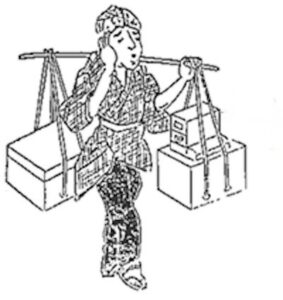
Drawing of a man carrying a ya-tai, 屋台, house-support. Such portable devices were used to sell utensils, offer foods, provide services, etc. Two ‘cabinets’ were carried with attached ropes hanging from a pole, called an i-kake-ya, 鋳掛屋, casting-hang-house; E-do Ji-dai, 江戸時代, River-door Time-period.
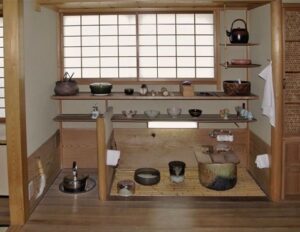
A gan–ro, 丸炉, round-hearth, is ideally present in the floor of the mizu–ya, 水屋, water-room, which contains a charcoal fire to heat water in a kama, 釜, kettle, and to start the burning of charcoal for the shita–bi, 下火, down-fire, in the hearth in the Tearoom. A ganro may be present in other rooms, such as the machi-ai, 待合, wait-gather, in cold weather to provide sa–yu, 白湯, white(clear)-hot water, for the guests to sample the water that is used in the presentation of tea.
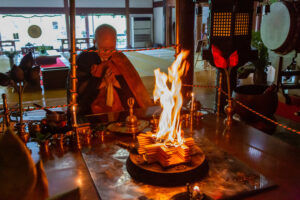
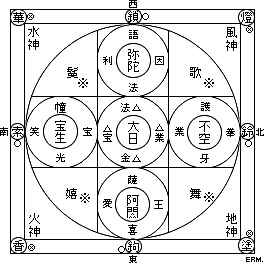
Left: Shin-gon, 真言, True-vow, priest offering the go-ma, 護摩, protect-polish, within the temple. The goma fire is often offered out of doors, as it originated in India.
Right: basic plan of the Kon–gō–kai Man-da-ra, 金剛界曼荼羅, Gold-strength-world Wide-weed-spread; circle of nine squares in a square. The central deity is Dai–nichi Nyo–rai, 大日如来, Great-sun Like-become, the Buddhist deity who is the universe made manifest.
Note the similarity of the shape of the nine square construction of both goma and mandara as well as fire, or the concept of fire, in the center of both. Go-ma, 護摩, Protect-polish, is a fire ceremony derived from India to honor the Hindu fire god Agni.
The fire of the goma is made of wooden sticks, go-ma-gi, 護摩木, protect-polish-wood, on which one writes their name and wish or prayer. The gomagi usually has the name of the temple or place of worship stamped on the stick. These are then given to the temple where they are kept until the next goma rite. The gomagi are put into the fire with the hope that the prayers rise up to the heavens and deities.
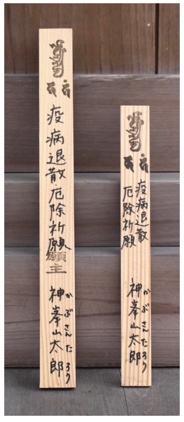
Two sizes of go-ma-gi, 護摩木, Protect-polish-wood, for the fire at Bi-sha-mon Fu-dō Go-ma, 毘沙門不動護摩, Aid-sand-gate No-move Protect-polish, at Ka-bu-san-ji, 神峯山寺, Spirit-peak-mountain-temple, Taka-tsuki-shi, 高槻市, Tall-zelkova, Ō-saka, 大阪, Great-slope.
There are three standard lengths of go-ma-gi, 護摩木, protect-polish-wood; 8 and 6.5 sun kane-jaku. There are three basic types of gomaki: dan-gi, 檀木, sandalwood-wood, sugi, 杉, cedar, sandalwood, spindle tree; 8 x .5 x .5 sun kane-jaku, available in bundles of 36 sticks.
A variety of gomagi is the nyū-moku, 乳木, milk-wood, also called shi-moku, 支木, branch-wood; 6 x .7 x .7 sun kane-jaku, available in bundles of 108 sticks, and bundles of 21, ni-jū-i-sshi, 二十一支, two-ten-one branch; 6.5 x .3 x .3 sun kane-jaku. The Kanji nyū, 乳, refers to the sap of living trees, so that nyūmoku sticks are made of wood that drips sap. The selected woods include hinoki, 檜, cypress, sugi, 杉, cedar, matsu, 松, pine, etc.
A third smaller gomagi is made of processed wood, tsuke-matsu, 付け松, attach-pine, L. 2 sun kane-jaku; available in bundles of various numbers of sticks.
The gomagi sticks are arranged to form a square on the round go-ma-dan, 護摩壇, protect-polish altar, which creates the basic design of a mandala. The ro of Chanoyu is a circle of ash within a square. In Chanoyu, during the formal presentation of building the charcoal fire, the ro-buchi, 炉縁, hearth-frame, is swept with a ha-bōki, 羽箒, feather-brush, writing the Kanji for kuchi, 口, mouth, which is also the katakana syllable ro, 口. The origin of the Kanji ro, 口, is derived from the Kanji ro, 呂, backbone.
During the go-ma, 護摩, protect-polish, the priest holds a bundle of gomagi with the left hand, and with the right hand takes three goma sticks, and tosses them one by one onto the fire. Errant sticks are replaced with long metal goma hi-bashi, 火箸, fire tongs.
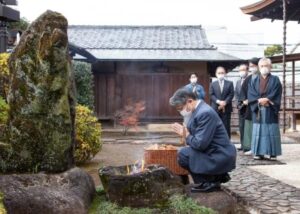
Headmasters of different schools of Chanoyu burn used chasen on December 8th. This rite is held annually at many temples and shrines around Japan. The large natural stone at the left is the permanent cha-sen-zuka, 茶筅塚, tea-whisk-monument. Perhaps the most interesting aspect of the rite, is that the chasen are burned in a stone basin, which is in great contrast to the similar stone chō-zu-bachi, 手水鉢, hand-water-bowl, in the ro-ji, 露地, dew-ground, garden of a Tea house, where one purifies the hands and mouth before having Tea.
In Japan, like many cultures around the world, people make burnt offerings. In the realm of Chanoyu, used cha-sen, 茶筅, tea-whisk, are burned in sacred fires in the ritual of cha-sen ku-yō, 茶筅供養, tea-whisk offer-service. According to the Eki-kyō, 易経, Change-sutra, I Ching, the chasen is identified with the trigram Ri, 離, detach, for the element of Fire.
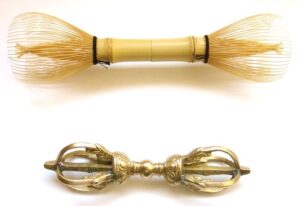
There is a strong resemblance between the chasen and the kon-gō-sho, 金剛杵, gold-strength-pestle, vajra motifs on the go-ma-ro, 護摩炉, protect-polish-hearth, and the go-ma kama, 護摩釜, protect-polish kettle. Because of their appearance, I put together two chasen to show the resemblance of the chasen to the vajra, kongōsho.
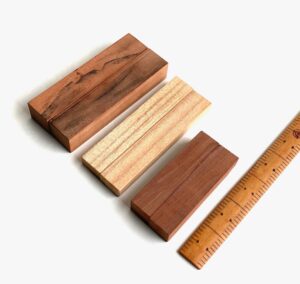
Pairs of suki-gi, 透木, clear-wood, from left:
For ro, sakura, 桜, cherry; L. 3.9 x .8 x .7 sun kane-jaku.
For ro: hinoki, 檜, cypress; L. 3.9 x .7 x .4 sun kane-jaku.
For furo, sakura, L. 3 x 6 x 5.5 sun kane-jaku.
It is possible that some sukigi are created by cutting a standard gomagi in half. The length of the two ro sukigi end to end is 7.8 sun. The length of the standard gomagi is 8 sun, the subtraction of 2 bu which may be attributed to the saw blade that cut the gomagi in half would create the sukigi that measures 7.8 sun.
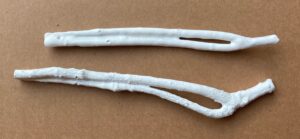
Eda-zumi, 枝炭, branch-charcoal; above for fu-ro, 風炉, wind-hearth, L. 5 sun kane-jaku; lower for ro, 炉, hearth, L. 5 sun kujira-jaku. Both edazumi have the same numerical dimension but are measured with two different rulers, mono-sashi, 物差し, thing-distinction.
Eda-zumi, 枝炭, branch-charcoal, that are put into the charcoal fire in the hearth, are made of two- and three-tine twigs of tsutsuji, 躑躅, azalea, and coated with a kind of gesso called go-fun, 胡粉, foreign-flour, made of ground clamshells. The length of edazumi for the furo is 5 sun kane-jaku, and for ro is 6 sun kane-jaku or 4.8 sun kujira-jaku (5 sun?). The edazumi resemble two-tine matsu-ba, 松葉, pine-leaf(needle). There also three-tine edazumi and three-tine matsuba. Some pine trees have 5-tine needles.
Pine needles are symbols of Infinity in Space, however when the ends of the needles join it is a sign of ending, death. Such design motifs called ore-matsu–ba, 折れ松葉, broken-pine-leaf, and are sometimes found as stitches on a Buddhist monk’s kesa strap.

The length of 6 sun kane-jaku, is the same as the nyū-moku, 乳木, milk-wood, also called shi-moku, 支木, branch-wood, that can be made of matsu, 松, pine wood. Note the similarity between the Kanji for eda, 枝, branch, and for shi, 支, branch. There may some close connection between the wood for the hearth for Chanoyu and the wood for the hearth for the rite of goma.
![]()
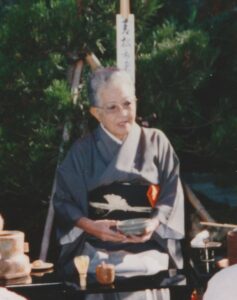
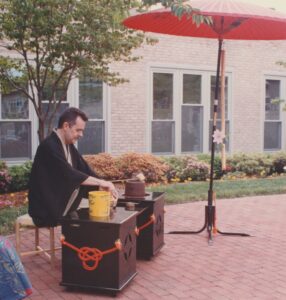
Shio-tsuki Ya-e-ko, 塩月弥栄子, Salt-moon Increase-splendor-child, hosting Tea at the Mi-sono dana, 御園棚, Hon.-garden-shelf, in the garden of Showa Women’s College in Jamaica Plain, Massachusetts. She was the first-born child of Tan-tan-sai, 淡々斎, Light-light-abstain, XIV Iemoto of Urasenke. Shiotsuki Sama’s mother Ka-yo-ko, 嘉代子, Auspicious-era-child, created the Misono Dana for her husband’s kan-reki, 還暦, return-calendar, 60th birthday.
In the following photograph, I am presenting usu-cha, 薄茶, thin-tea, using the misono dana in the same garden at Showa in 1996.
For further study, see also: Charcoal: Sumi for Furo andRo, Furo Ro: Three Forms, and Furo to Ro

